MSc Project Management: Operational Management of Virtual Teams
VerifiedAdded on 2019/09/20
|13
|3801
|143
Project
AI Summary
This project proposal, submitted for a Master's degree in Project Management at Birmingham City University, investigates the operational management of virtual teams within small IT firms. It addresses the challenges and advantages of using virtual teams, the impact on IT projects, and the importance of efficient management strategies. The research aims to identify effective methods for small IT businesses to handle virtual teams, considering technological advancements and the need for KSA (knowledge, skills, and abilities). The proposal outlines the research question, objectives, methodology (including primary and secondary sources, and the use of SPSS for data analysis), project philosophy, and anticipated schedule. The project emphasizes the importance of adapting to technological changes and the need for proper leadership and supervision to mitigate potential conflicts and improve project outcomes. The proposal also touches on the business models and the statistics will be shown that will help in suggesting the ways which can help these small businesses in dealing with their virtual teams.
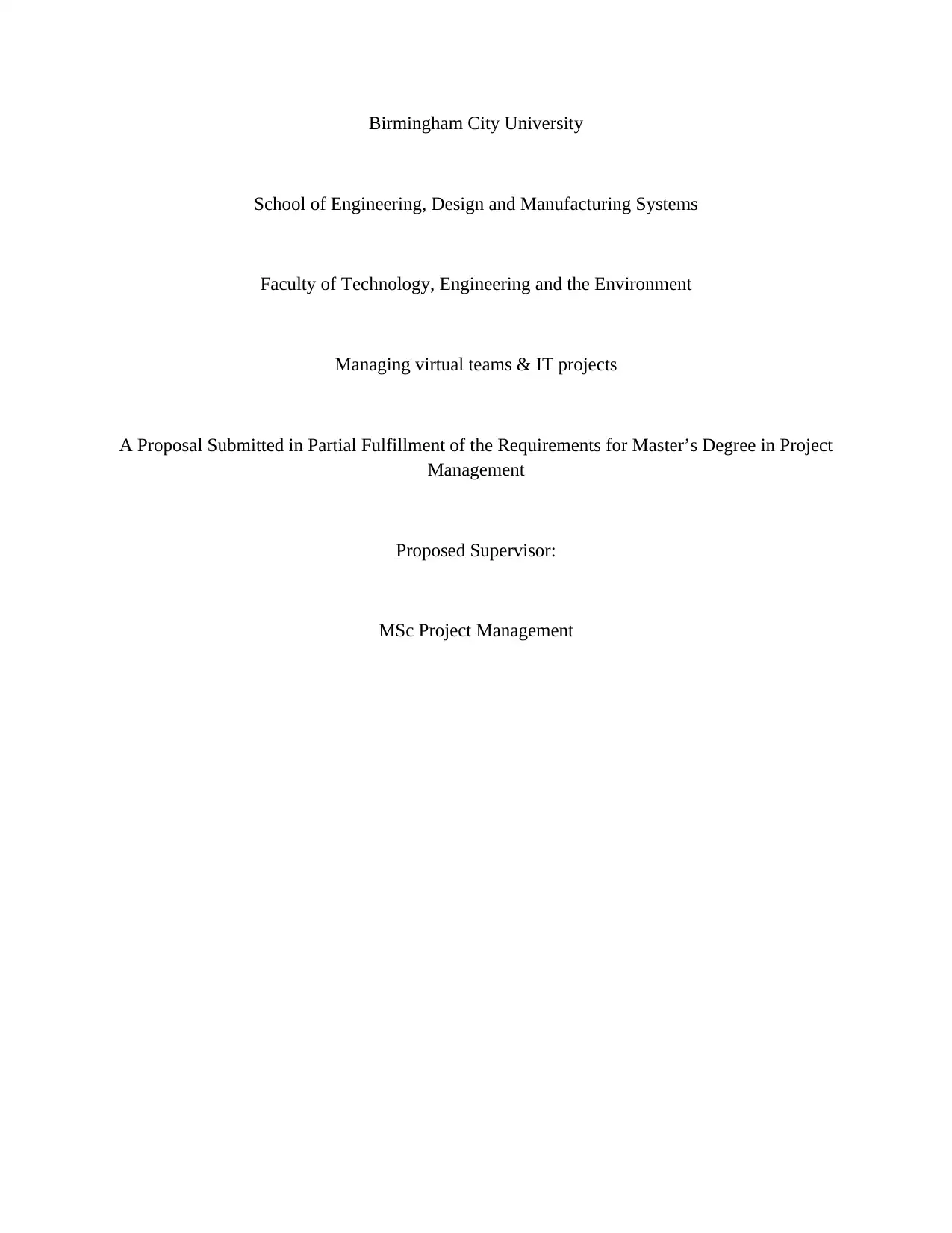
Birmingham City University
School of Engineering, Design and Manufacturing Systems
Faculty of Technology, Engineering and the Environment
Managing virtual teams & IT projects
A Proposal Submitted in Partial Fulfillment of the Requirements for Master’s Degree in Project
Management
Proposed Supervisor:
MSc Project Management
School of Engineering, Design and Manufacturing Systems
Faculty of Technology, Engineering and the Environment
Managing virtual teams & IT projects
A Proposal Submitted in Partial Fulfillment of the Requirements for Master’s Degree in Project
Management
Proposed Supervisor:
MSc Project Management
Paraphrase This Document
Need a fresh take? Get an instant paraphrase of this document with our AI Paraphraser

1
Table of Contents
Introduction......................................................................................................................................2
Background......................................................................................................................................3
Aim..................................................................................................................................................4
Objectives........................................................................................................................................4
Research Question...........................................................................................................................4
Project Philosophy...........................................................................................................................4
Methodology....................................................................................................................................7
Instrument........................................................................................................................................7
Framework.......................................................................................................................................7
Primary sources................................................................................................................................9
Secondary Sources...........................................................................................................................9
Research Ethics................................................................................................................................9
Supervision......................................................................................................................................9
Schedule.........................................................................................................................................10
Conclusion.....................................................................................................................................10
References......................................................................................................................................11
Table of Contents
Introduction......................................................................................................................................2
Background......................................................................................................................................3
Aim..................................................................................................................................................4
Objectives........................................................................................................................................4
Research Question...........................................................................................................................4
Project Philosophy...........................................................................................................................4
Methodology....................................................................................................................................7
Instrument........................................................................................................................................7
Framework.......................................................................................................................................7
Primary sources................................................................................................................................9
Secondary Sources...........................................................................................................................9
Research Ethics................................................................................................................................9
Supervision......................................................................................................................................9
Schedule.........................................................................................................................................10
Conclusion.....................................................................................................................................10
References......................................................................................................................................11
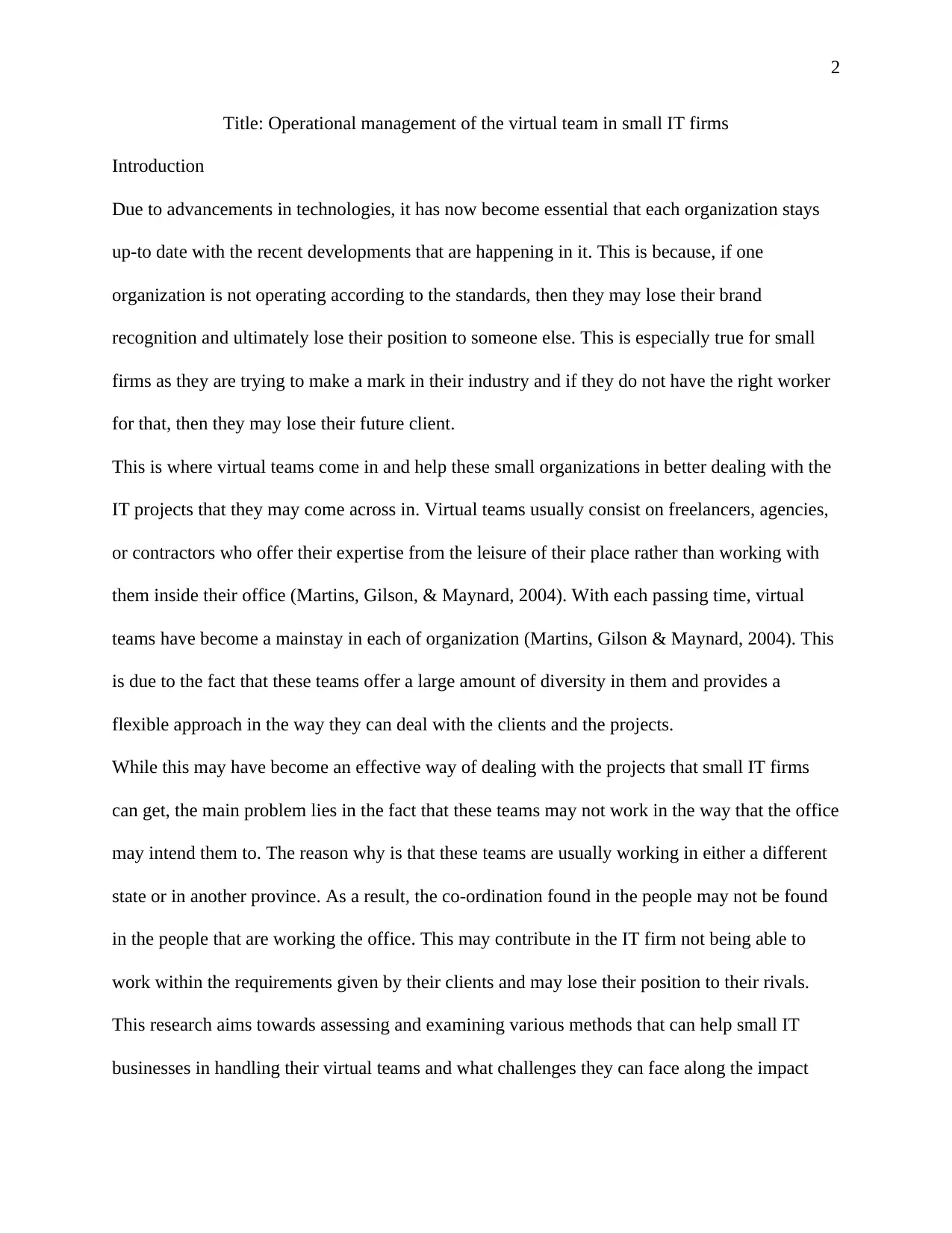
2
Title: Operational management of the virtual team in small IT firms
Introduction
Due to advancements in technologies, it has now become essential that each organization stays
up-to date with the recent developments that are happening in it. This is because, if one
organization is not operating according to the standards, then they may lose their brand
recognition and ultimately lose their position to someone else. This is especially true for small
firms as they are trying to make a mark in their industry and if they do not have the right worker
for that, then they may lose their future client.
This is where virtual teams come in and help these small organizations in better dealing with the
IT projects that they may come across in. Virtual teams usually consist on freelancers, agencies,
or contractors who offer their expertise from the leisure of their place rather than working with
them inside their office (Martins, Gilson, & Maynard, 2004). With each passing time, virtual
teams have become a mainstay in each of organization (Martins, Gilson & Maynard, 2004). This
is due to the fact that these teams offer a large amount of diversity in them and provides a
flexible approach in the way they can deal with the clients and the projects.
While this may have become an effective way of dealing with the projects that small IT firms
can get, the main problem lies in the fact that these teams may not work in the way that the office
may intend them to. The reason why is that these teams are usually working in either a different
state or in another province. As a result, the co-ordination found in the people may not be found
in the people that are working the office. This may contribute in the IT firm not being able to
work within the requirements given by their clients and may lose their position to their rivals.
This research aims towards assessing and examining various methods that can help small IT
businesses in handling their virtual teams and what challenges they can face along the impact
Title: Operational management of the virtual team in small IT firms
Introduction
Due to advancements in technologies, it has now become essential that each organization stays
up-to date with the recent developments that are happening in it. This is because, if one
organization is not operating according to the standards, then they may lose their brand
recognition and ultimately lose their position to someone else. This is especially true for small
firms as they are trying to make a mark in their industry and if they do not have the right worker
for that, then they may lose their future client.
This is where virtual teams come in and help these small organizations in better dealing with the
IT projects that they may come across in. Virtual teams usually consist on freelancers, agencies,
or contractors who offer their expertise from the leisure of their place rather than working with
them inside their office (Martins, Gilson, & Maynard, 2004). With each passing time, virtual
teams have become a mainstay in each of organization (Martins, Gilson & Maynard, 2004). This
is due to the fact that these teams offer a large amount of diversity in them and provides a
flexible approach in the way they can deal with the clients and the projects.
While this may have become an effective way of dealing with the projects that small IT firms
can get, the main problem lies in the fact that these teams may not work in the way that the office
may intend them to. The reason why is that these teams are usually working in either a different
state or in another province. As a result, the co-ordination found in the people may not be found
in the people that are working the office. This may contribute in the IT firm not being able to
work within the requirements given by their clients and may lose their position to their rivals.
This research aims towards assessing and examining various methods that can help small IT
businesses in handling their virtual teams and what challenges they can face along the impact
⊘ This is a preview!⊘
Do you want full access?
Subscribe today to unlock all pages.

Trusted by 1+ million students worldwide
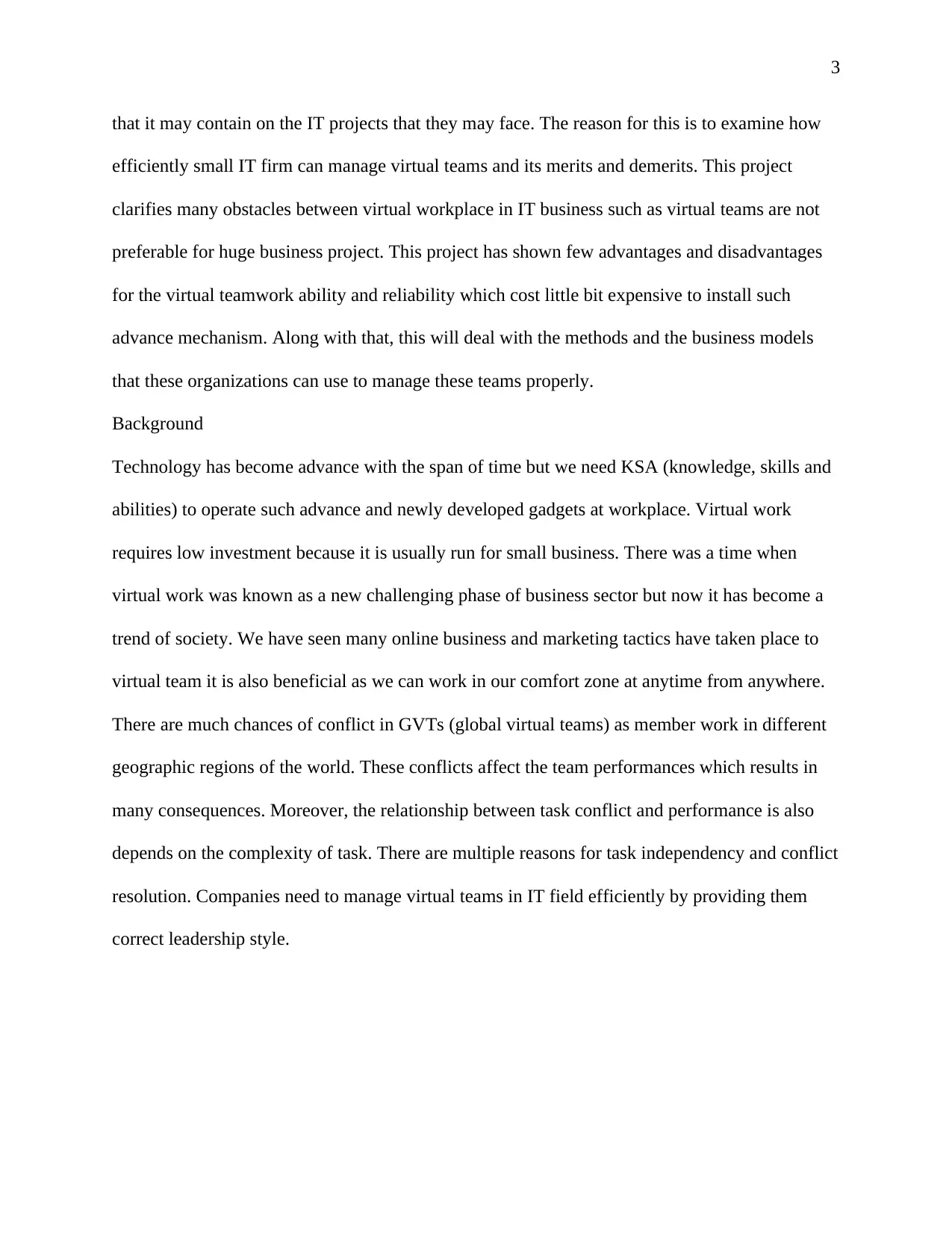
3
that it may contain on the IT projects that they may face. The reason for this is to examine how
efficiently small IT firm can manage virtual teams and its merits and demerits. This project
clarifies many obstacles between virtual workplace in IT business such as virtual teams are not
preferable for huge business project. This project has shown few advantages and disadvantages
for the virtual teamwork ability and reliability which cost little bit expensive to install such
advance mechanism. Along with that, this will deal with the methods and the business models
that these organizations can use to manage these teams properly.
Background
Technology has become advance with the span of time but we need KSA (knowledge, skills and
abilities) to operate such advance and newly developed gadgets at workplace. Virtual work
requires low investment because it is usually run for small business. There was a time when
virtual work was known as a new challenging phase of business sector but now it has become a
trend of society. We have seen many online business and marketing tactics have taken place to
virtual team it is also beneficial as we can work in our comfort zone at anytime from anywhere.
There are much chances of conflict in GVTs (global virtual teams) as member work in different
geographic regions of the world. These conflicts affect the team performances which results in
many consequences. Moreover, the relationship between task conflict and performance is also
depends on the complexity of task. There are multiple reasons for task independency and conflict
resolution. Companies need to manage virtual teams in IT field efficiently by providing them
correct leadership style.
that it may contain on the IT projects that they may face. The reason for this is to examine how
efficiently small IT firm can manage virtual teams and its merits and demerits. This project
clarifies many obstacles between virtual workplace in IT business such as virtual teams are not
preferable for huge business project. This project has shown few advantages and disadvantages
for the virtual teamwork ability and reliability which cost little bit expensive to install such
advance mechanism. Along with that, this will deal with the methods and the business models
that these organizations can use to manage these teams properly.
Background
Technology has become advance with the span of time but we need KSA (knowledge, skills and
abilities) to operate such advance and newly developed gadgets at workplace. Virtual work
requires low investment because it is usually run for small business. There was a time when
virtual work was known as a new challenging phase of business sector but now it has become a
trend of society. We have seen many online business and marketing tactics have taken place to
virtual team it is also beneficial as we can work in our comfort zone at anytime from anywhere.
There are much chances of conflict in GVTs (global virtual teams) as member work in different
geographic regions of the world. These conflicts affect the team performances which results in
many consequences. Moreover, the relationship between task conflict and performance is also
depends on the complexity of task. There are multiple reasons for task independency and conflict
resolution. Companies need to manage virtual teams in IT field efficiently by providing them
correct leadership style.
Paraphrase This Document
Need a fresh take? Get an instant paraphrase of this document with our AI Paraphraser
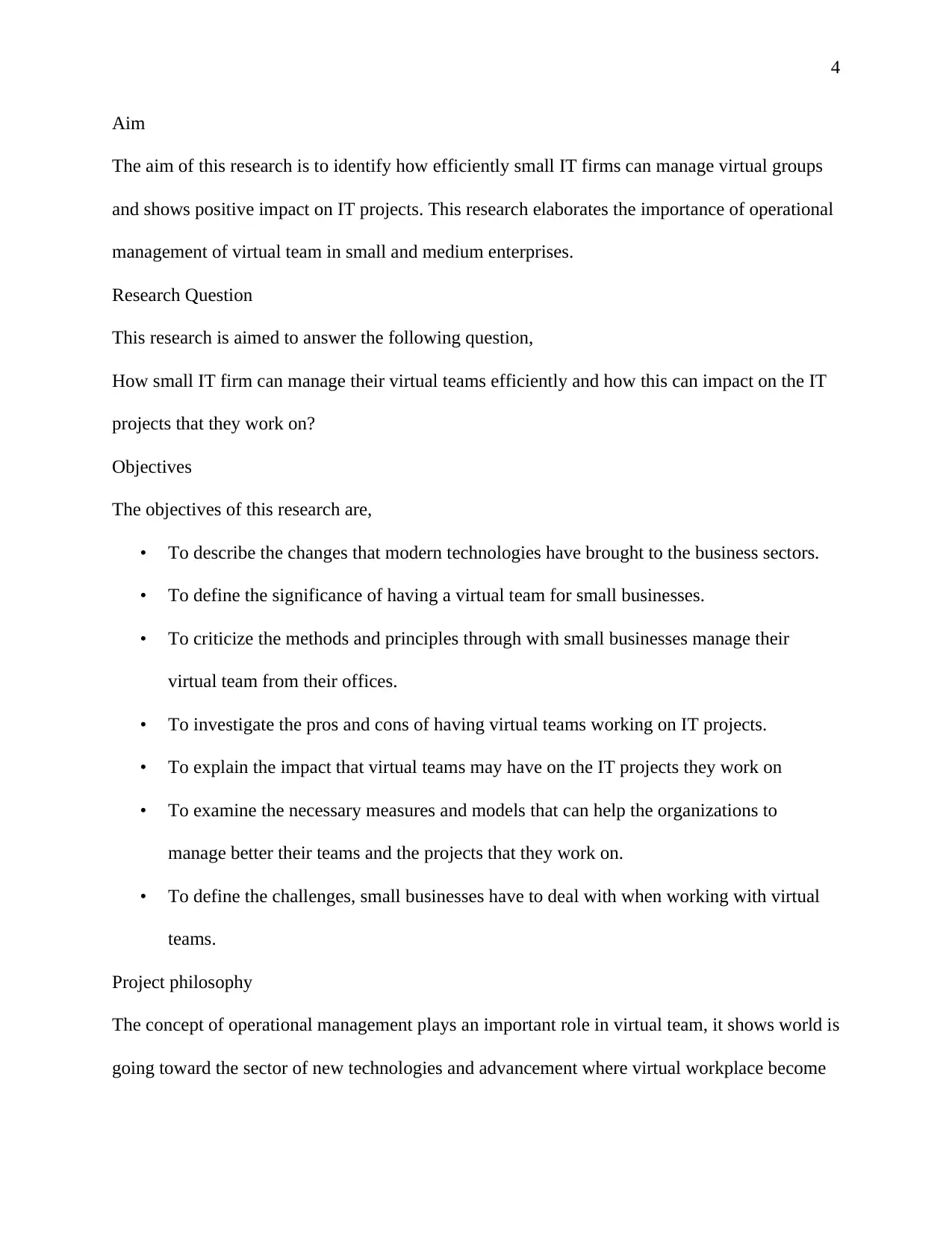
4
Aim
The aim of this research is to identify how efficiently small IT firms can manage virtual groups
and shows positive impact on IT projects. This research elaborates the importance of operational
management of virtual team in small and medium enterprises.
Research Question
This research is aimed to answer the following question,
How small IT firm can manage their virtual teams efficiently and how this can impact on the IT
projects that they work on?
Objectives
The objectives of this research are,
• To describe the changes that modern technologies have brought to the business sectors.
• To define the significance of having a virtual team for small businesses.
• To criticize the methods and principles through with small businesses manage their
virtual team from their offices.
• To investigate the pros and cons of having virtual teams working on IT projects.
• To explain the impact that virtual teams may have on the IT projects they work on
• To examine the necessary measures and models that can help the organizations to
manage better their teams and the projects that they work on.
• To define the challenges, small businesses have to deal with when working with virtual
teams.
Project philosophy
The concept of operational management plays an important role in virtual team, it shows world is
going toward the sector of new technologies and advancement where virtual workplace become
Aim
The aim of this research is to identify how efficiently small IT firms can manage virtual groups
and shows positive impact on IT projects. This research elaborates the importance of operational
management of virtual team in small and medium enterprises.
Research Question
This research is aimed to answer the following question,
How small IT firm can manage their virtual teams efficiently and how this can impact on the IT
projects that they work on?
Objectives
The objectives of this research are,
• To describe the changes that modern technologies have brought to the business sectors.
• To define the significance of having a virtual team for small businesses.
• To criticize the methods and principles through with small businesses manage their
virtual team from their offices.
• To investigate the pros and cons of having virtual teams working on IT projects.
• To explain the impact that virtual teams may have on the IT projects they work on
• To examine the necessary measures and models that can help the organizations to
manage better their teams and the projects that they work on.
• To define the challenges, small businesses have to deal with when working with virtual
teams.
Project philosophy
The concept of operational management plays an important role in virtual team, it shows world is
going toward the sector of new technologies and advancement where virtual workplace become
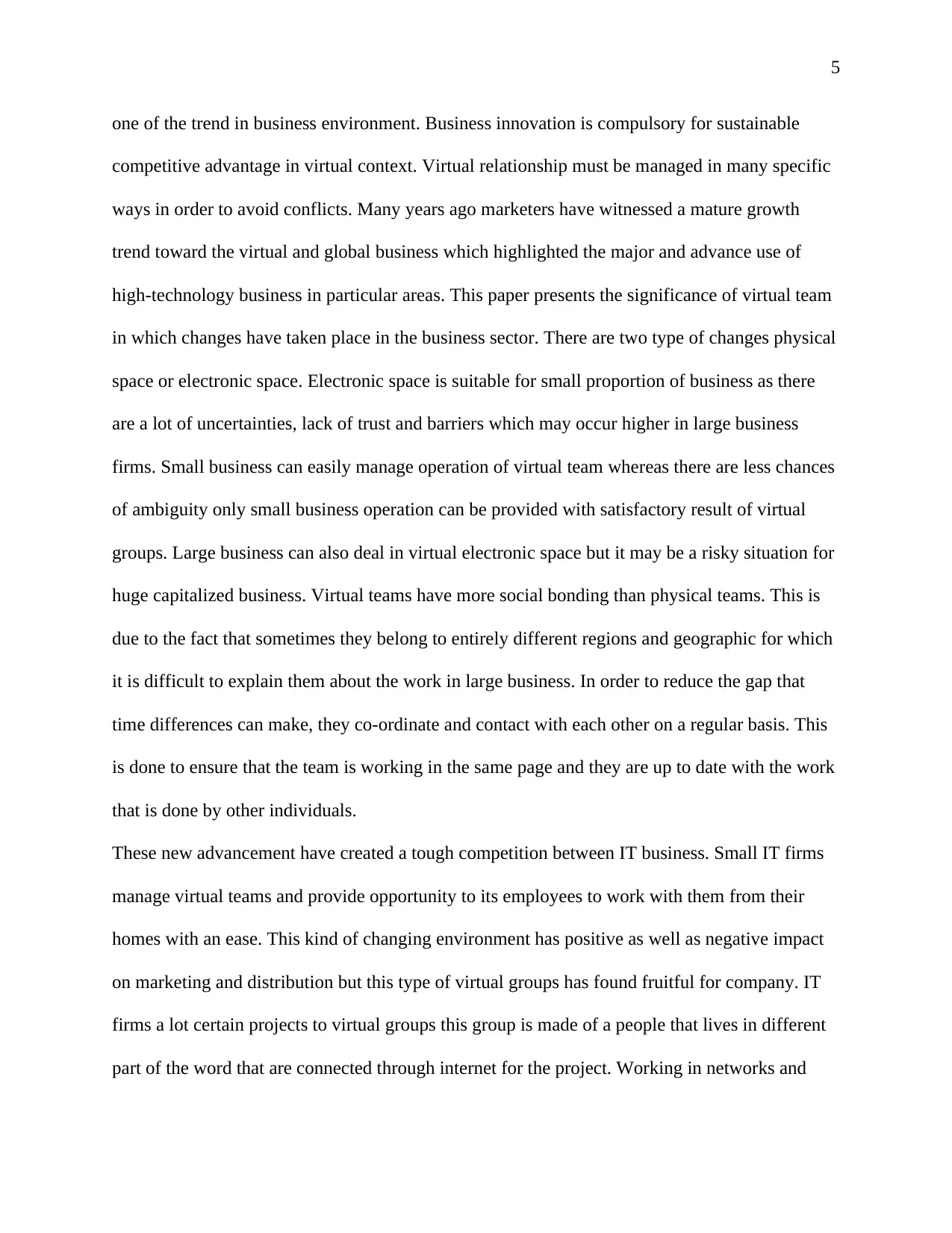
5
one of the trend in business environment. Business innovation is compulsory for sustainable
competitive advantage in virtual context. Virtual relationship must be managed in many specific
ways in order to avoid conflicts. Many years ago marketers have witnessed a mature growth
trend toward the virtual and global business which highlighted the major and advance use of
high-technology business in particular areas. This paper presents the significance of virtual team
in which changes have taken place in the business sector. There are two type of changes physical
space or electronic space. Electronic space is suitable for small proportion of business as there
are a lot of uncertainties, lack of trust and barriers which may occur higher in large business
firms. Small business can easily manage operation of virtual team whereas there are less chances
of ambiguity only small business operation can be provided with satisfactory result of virtual
groups. Large business can also deal in virtual electronic space but it may be a risky situation for
huge capitalized business. Virtual teams have more social bonding than physical teams. This is
due to the fact that sometimes they belong to entirely different regions and geographic for which
it is difficult to explain them about the work in large business. In order to reduce the gap that
time differences can make, they co-ordinate and contact with each other on a regular basis. This
is done to ensure that the team is working in the same page and they are up to date with the work
that is done by other individuals.
These new advancement have created a tough competition between IT business. Small IT firms
manage virtual teams and provide opportunity to its employees to work with them from their
homes with an ease. This kind of changing environment has positive as well as negative impact
on marketing and distribution but this type of virtual groups has found fruitful for company. IT
firms a lot certain projects to virtual groups this group is made of a people that lives in different
part of the word that are connected through internet for the project. Working in networks and
one of the trend in business environment. Business innovation is compulsory for sustainable
competitive advantage in virtual context. Virtual relationship must be managed in many specific
ways in order to avoid conflicts. Many years ago marketers have witnessed a mature growth
trend toward the virtual and global business which highlighted the major and advance use of
high-technology business in particular areas. This paper presents the significance of virtual team
in which changes have taken place in the business sector. There are two type of changes physical
space or electronic space. Electronic space is suitable for small proportion of business as there
are a lot of uncertainties, lack of trust and barriers which may occur higher in large business
firms. Small business can easily manage operation of virtual team whereas there are less chances
of ambiguity only small business operation can be provided with satisfactory result of virtual
groups. Large business can also deal in virtual electronic space but it may be a risky situation for
huge capitalized business. Virtual teams have more social bonding than physical teams. This is
due to the fact that sometimes they belong to entirely different regions and geographic for which
it is difficult to explain them about the work in large business. In order to reduce the gap that
time differences can make, they co-ordinate and contact with each other on a regular basis. This
is done to ensure that the team is working in the same page and they are up to date with the work
that is done by other individuals.
These new advancement have created a tough competition between IT business. Small IT firms
manage virtual teams and provide opportunity to its employees to work with them from their
homes with an ease. This kind of changing environment has positive as well as negative impact
on marketing and distribution but this type of virtual groups has found fruitful for company. IT
firms a lot certain projects to virtual groups this group is made of a people that lives in different
part of the word that are connected through internet for the project. Working in networks and
⊘ This is a preview!⊘
Do you want full access?
Subscribe today to unlock all pages.

Trusted by 1+ million students worldwide
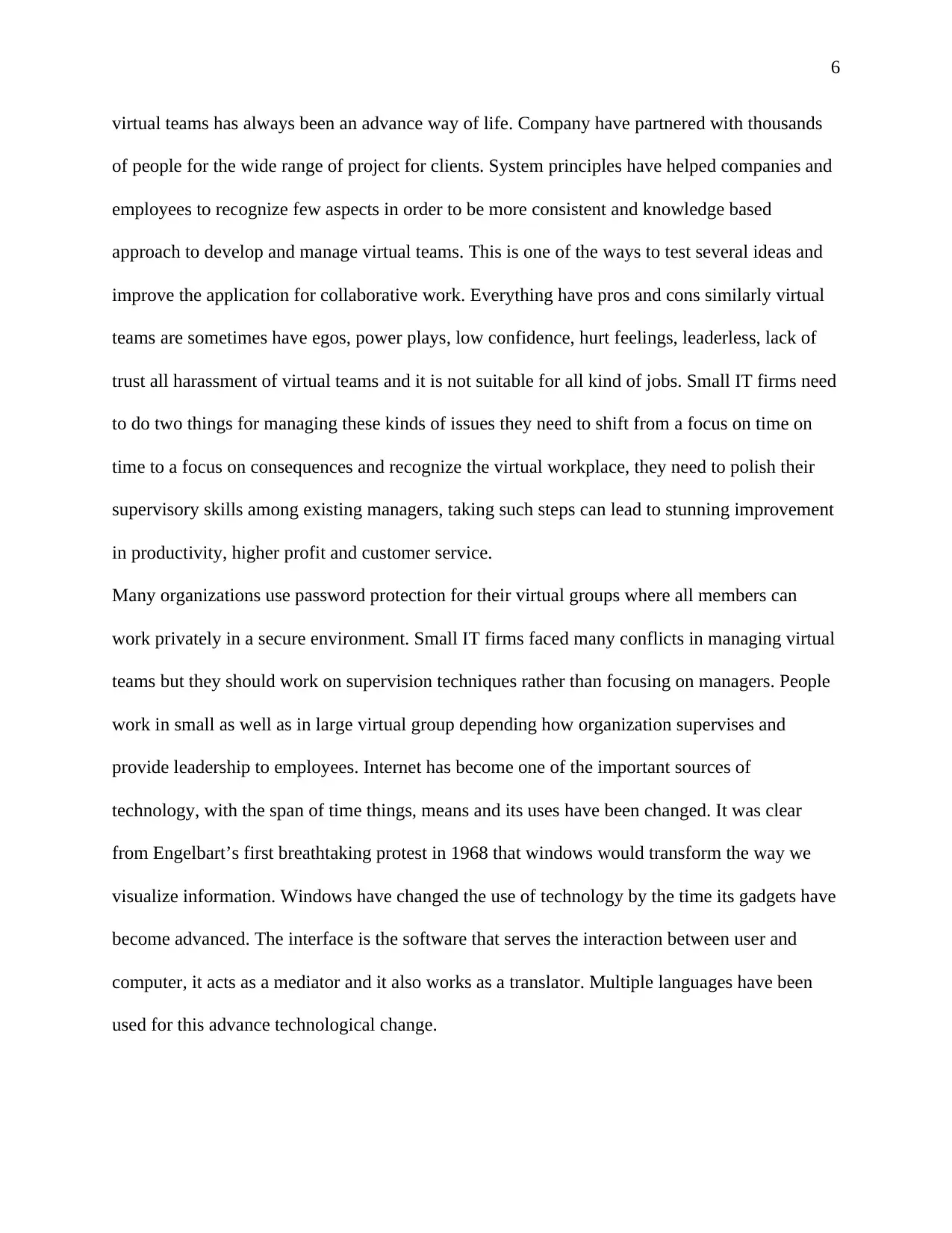
6
virtual teams has always been an advance way of life. Company have partnered with thousands
of people for the wide range of project for clients. System principles have helped companies and
employees to recognize few aspects in order to be more consistent and knowledge based
approach to develop and manage virtual teams. This is one of the ways to test several ideas and
improve the application for collaborative work. Everything have pros and cons similarly virtual
teams are sometimes have egos, power plays, low confidence, hurt feelings, leaderless, lack of
trust all harassment of virtual teams and it is not suitable for all kind of jobs. Small IT firms need
to do two things for managing these kinds of issues they need to shift from a focus on time on
time to a focus on consequences and recognize the virtual workplace, they need to polish their
supervisory skills among existing managers, taking such steps can lead to stunning improvement
in productivity, higher profit and customer service.
Many organizations use password protection for their virtual groups where all members can
work privately in a secure environment. Small IT firms faced many conflicts in managing virtual
teams but they should work on supervision techniques rather than focusing on managers. People
work in small as well as in large virtual group depending how organization supervises and
provide leadership to employees. Internet has become one of the important sources of
technology, with the span of time things, means and its uses have been changed. It was clear
from Engelbart’s first breathtaking protest in 1968 that windows would transform the way we
visualize information. Windows have changed the use of technology by the time its gadgets have
become advanced. The interface is the software that serves the interaction between user and
computer, it acts as a mediator and it also works as a translator. Multiple languages have been
used for this advance technological change.
virtual teams has always been an advance way of life. Company have partnered with thousands
of people for the wide range of project for clients. System principles have helped companies and
employees to recognize few aspects in order to be more consistent and knowledge based
approach to develop and manage virtual teams. This is one of the ways to test several ideas and
improve the application for collaborative work. Everything have pros and cons similarly virtual
teams are sometimes have egos, power plays, low confidence, hurt feelings, leaderless, lack of
trust all harassment of virtual teams and it is not suitable for all kind of jobs. Small IT firms need
to do two things for managing these kinds of issues they need to shift from a focus on time on
time to a focus on consequences and recognize the virtual workplace, they need to polish their
supervisory skills among existing managers, taking such steps can lead to stunning improvement
in productivity, higher profit and customer service.
Many organizations use password protection for their virtual groups where all members can
work privately in a secure environment. Small IT firms faced many conflicts in managing virtual
teams but they should work on supervision techniques rather than focusing on managers. People
work in small as well as in large virtual group depending how organization supervises and
provide leadership to employees. Internet has become one of the important sources of
technology, with the span of time things, means and its uses have been changed. It was clear
from Engelbart’s first breathtaking protest in 1968 that windows would transform the way we
visualize information. Windows have changed the use of technology by the time its gadgets have
become advanced. The interface is the software that serves the interaction between user and
computer, it acts as a mediator and it also works as a translator. Multiple languages have been
used for this advance technological change.
Paraphrase This Document
Need a fresh take? Get an instant paraphrase of this document with our AI Paraphraser
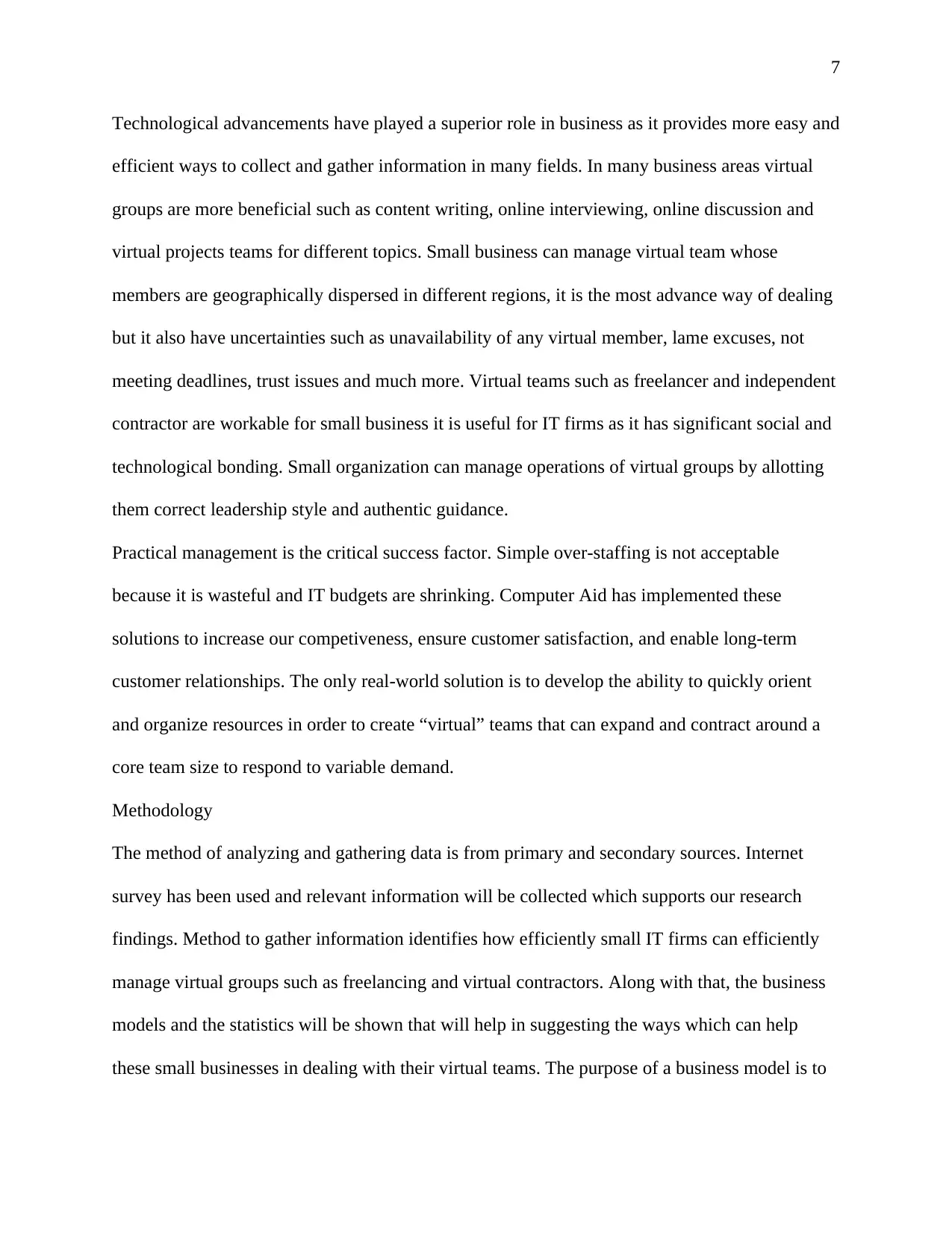
7
Technological advancements have played a superior role in business as it provides more easy and
efficient ways to collect and gather information in many fields. In many business areas virtual
groups are more beneficial such as content writing, online interviewing, online discussion and
virtual projects teams for different topics. Small business can manage virtual team whose
members are geographically dispersed in different regions, it is the most advance way of dealing
but it also have uncertainties such as unavailability of any virtual member, lame excuses, not
meeting deadlines, trust issues and much more. Virtual teams such as freelancer and independent
contractor are workable for small business it is useful for IT firms as it has significant social and
technological bonding. Small organization can manage operations of virtual groups by allotting
them correct leadership style and authentic guidance.
Practical management is the critical success factor. Simple over-staffing is not acceptable
because it is wasteful and IT budgets are shrinking. Computer Aid has implemented these
solutions to increase our competiveness, ensure customer satisfaction, and enable long-term
customer relationships. The only real-world solution is to develop the ability to quickly orient
and organize resources in order to create “virtual” teams that can expand and contract around a
core team size to respond to variable demand.
Methodology
The method of analyzing and gathering data is from primary and secondary sources. Internet
survey has been used and relevant information will be collected which supports our research
findings. Method to gather information identifies how efficiently small IT firms can efficiently
manage virtual groups such as freelancing and virtual contractors. Along with that, the business
models and the statistics will be shown that will help in suggesting the ways which can help
these small businesses in dealing with their virtual teams. The purpose of a business model is to
Technological advancements have played a superior role in business as it provides more easy and
efficient ways to collect and gather information in many fields. In many business areas virtual
groups are more beneficial such as content writing, online interviewing, online discussion and
virtual projects teams for different topics. Small business can manage virtual team whose
members are geographically dispersed in different regions, it is the most advance way of dealing
but it also have uncertainties such as unavailability of any virtual member, lame excuses, not
meeting deadlines, trust issues and much more. Virtual teams such as freelancer and independent
contractor are workable for small business it is useful for IT firms as it has significant social and
technological bonding. Small organization can manage operations of virtual groups by allotting
them correct leadership style and authentic guidance.
Practical management is the critical success factor. Simple over-staffing is not acceptable
because it is wasteful and IT budgets are shrinking. Computer Aid has implemented these
solutions to increase our competiveness, ensure customer satisfaction, and enable long-term
customer relationships. The only real-world solution is to develop the ability to quickly orient
and organize resources in order to create “virtual” teams that can expand and contract around a
core team size to respond to variable demand.
Methodology
The method of analyzing and gathering data is from primary and secondary sources. Internet
survey has been used and relevant information will be collected which supports our research
findings. Method to gather information identifies how efficiently small IT firms can efficiently
manage virtual groups such as freelancing and virtual contractors. Along with that, the business
models and the statistics will be shown that will help in suggesting the ways which can help
these small businesses in dealing with their virtual teams. The purpose of a business model is to
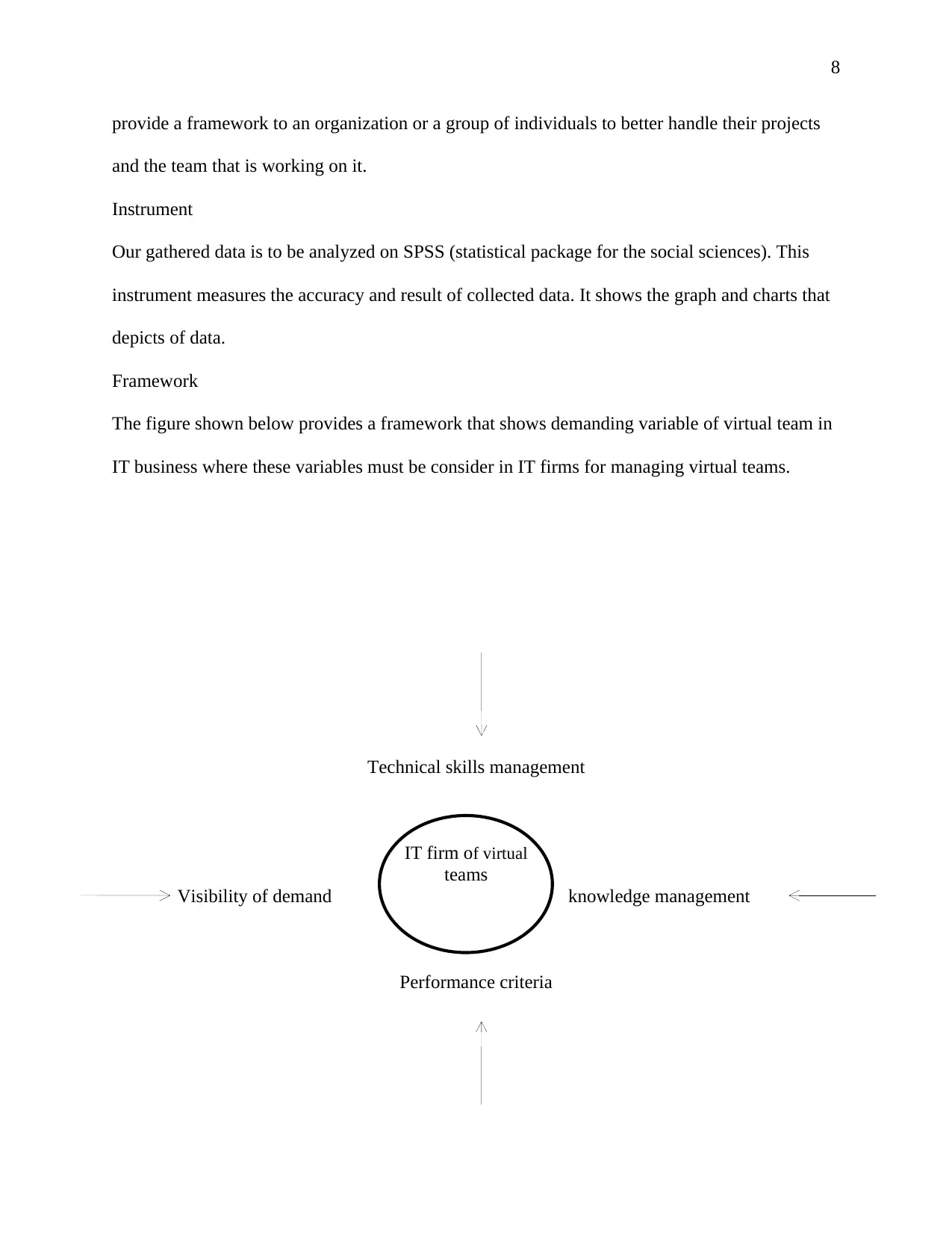
IT firm of virtual
teams
8
provide a framework to an organization or a group of individuals to better handle their projects
and the team that is working on it.
Instrument
Our gathered data is to be analyzed on SPSS (statistical package for the social sciences). This
instrument measures the accuracy and result of collected data. It shows the graph and charts that
depicts of data.
Framework
The figure shown below provides a framework that shows demanding variable of virtual team in
IT business where these variables must be consider in IT firms for managing virtual teams.
Technical skills management
Visibility of demand knowledge management
Performance criteria
teams
8
provide a framework to an organization or a group of individuals to better handle their projects
and the team that is working on it.
Instrument
Our gathered data is to be analyzed on SPSS (statistical package for the social sciences). This
instrument measures the accuracy and result of collected data. It shows the graph and charts that
depicts of data.
Framework
The figure shown below provides a framework that shows demanding variable of virtual team in
IT business where these variables must be consider in IT firms for managing virtual teams.
Technical skills management
Visibility of demand knowledge management
Performance criteria
⊘ This is a preview!⊘
Do you want full access?
Subscribe today to unlock all pages.

Trusted by 1+ million students worldwide
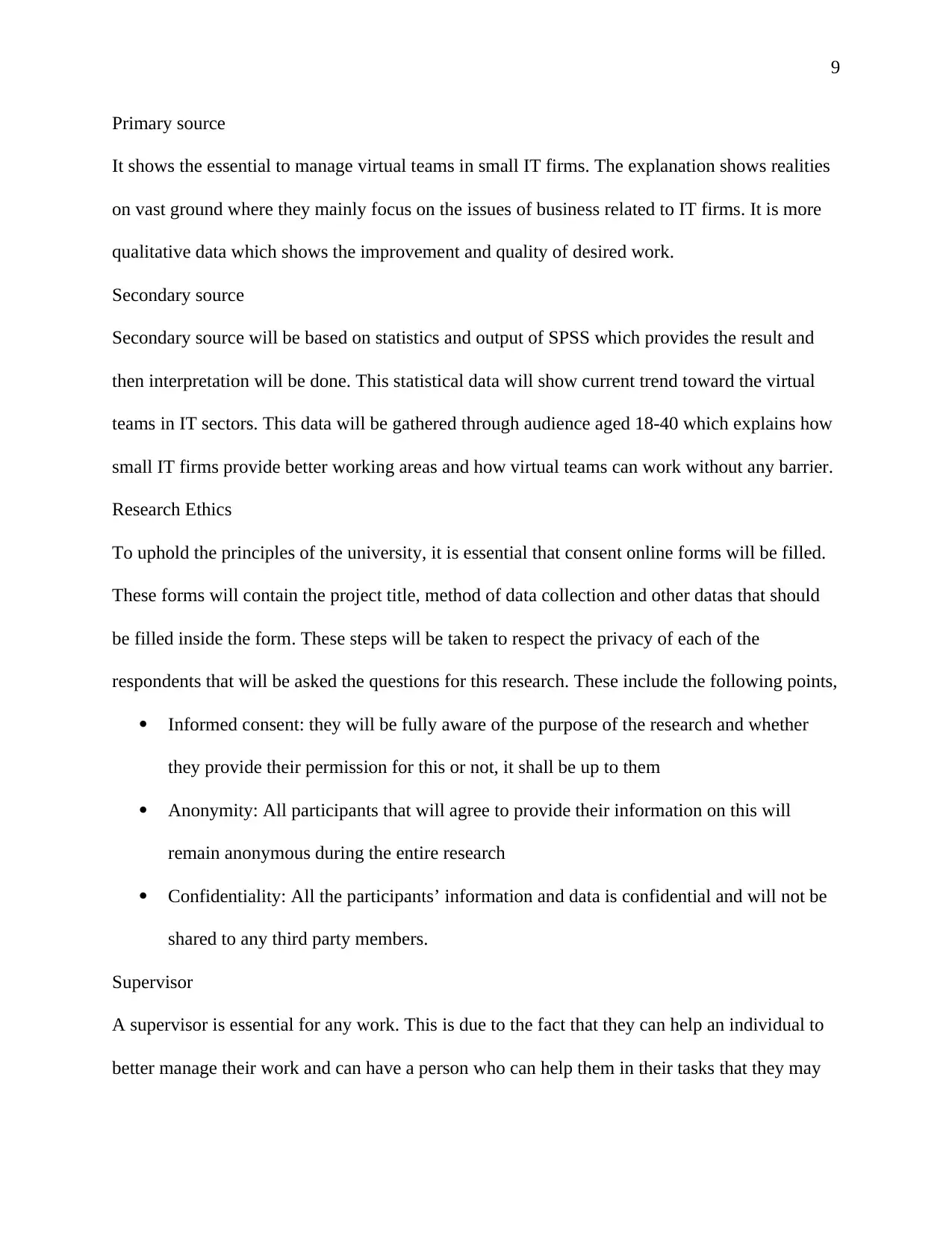
9
Primary source
It shows the essential to manage virtual teams in small IT firms. The explanation shows realities
on vast ground where they mainly focus on the issues of business related to IT firms. It is more
qualitative data which shows the improvement and quality of desired work.
Secondary source
Secondary source will be based on statistics and output of SPSS which provides the result and
then interpretation will be done. This statistical data will show current trend toward the virtual
teams in IT sectors. This data will be gathered through audience aged 18-40 which explains how
small IT firms provide better working areas and how virtual teams can work without any barrier.
Research Ethics
To uphold the principles of the university, it is essential that consent online forms will be filled.
These forms will contain the project title, method of data collection and other datas that should
be filled inside the form. These steps will be taken to respect the privacy of each of the
respondents that will be asked the questions for this research. These include the following points,
Informed consent: they will be fully aware of the purpose of the research and whether
they provide their permission for this or not, it shall be up to them
Anonymity: All participants that will agree to provide their information on this will
remain anonymous during the entire research
Confidentiality: All the participants’ information and data is confidential and will not be
shared to any third party members.
Supervisor
A supervisor is essential for any work. This is due to the fact that they can help an individual to
better manage their work and can have a person who can help them in their tasks that they may
Primary source
It shows the essential to manage virtual teams in small IT firms. The explanation shows realities
on vast ground where they mainly focus on the issues of business related to IT firms. It is more
qualitative data which shows the improvement and quality of desired work.
Secondary source
Secondary source will be based on statistics and output of SPSS which provides the result and
then interpretation will be done. This statistical data will show current trend toward the virtual
teams in IT sectors. This data will be gathered through audience aged 18-40 which explains how
small IT firms provide better working areas and how virtual teams can work without any barrier.
Research Ethics
To uphold the principles of the university, it is essential that consent online forms will be filled.
These forms will contain the project title, method of data collection and other datas that should
be filled inside the form. These steps will be taken to respect the privacy of each of the
respondents that will be asked the questions for this research. These include the following points,
Informed consent: they will be fully aware of the purpose of the research and whether
they provide their permission for this or not, it shall be up to them
Anonymity: All participants that will agree to provide their information on this will
remain anonymous during the entire research
Confidentiality: All the participants’ information and data is confidential and will not be
shared to any third party members.
Supervisor
A supervisor is essential for any work. This is due to the fact that they can help an individual to
better manage their work and can have a person who can help them in their tasks that they may
Paraphrase This Document
Need a fresh take? Get an instant paraphrase of this document with our AI Paraphraser
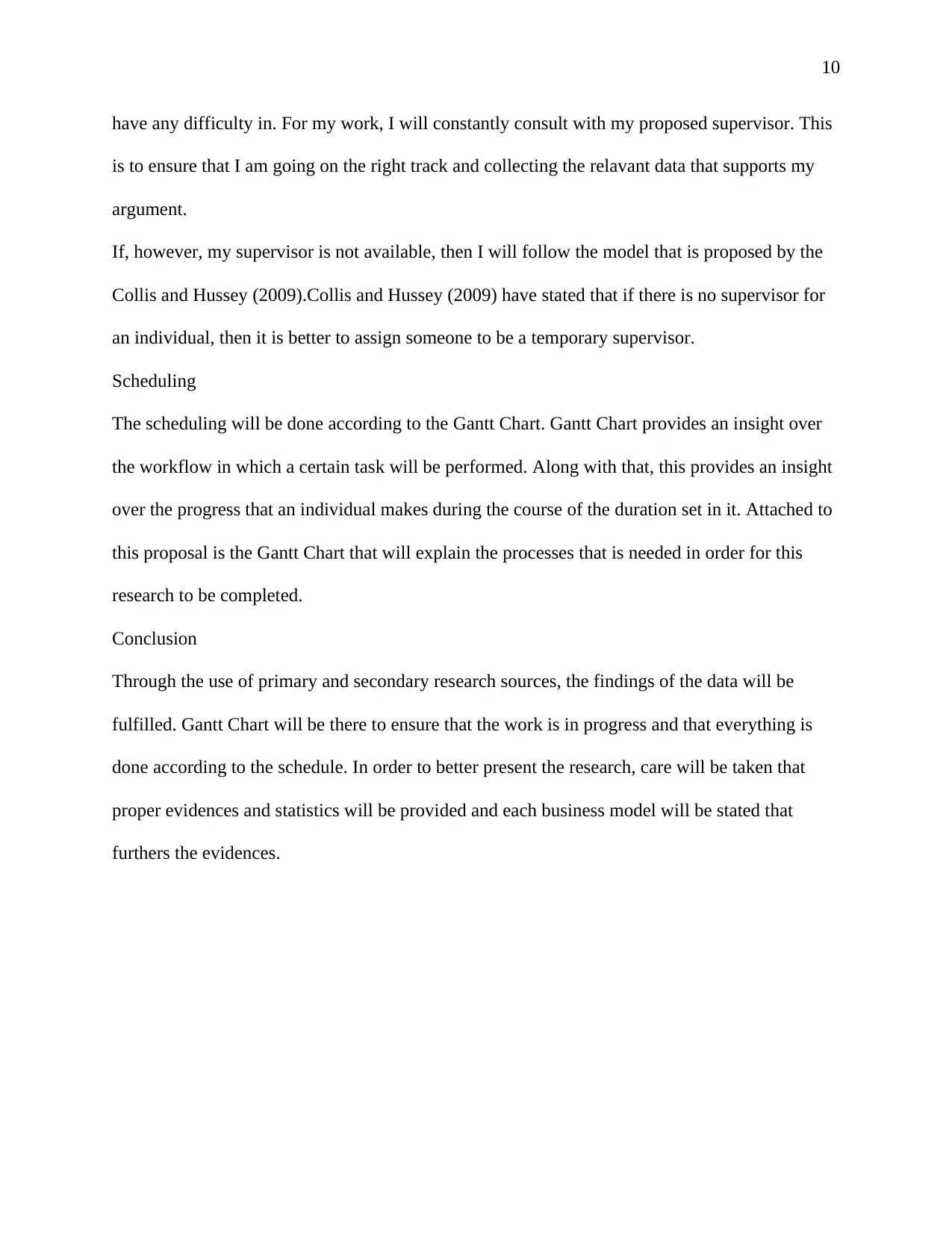
10
have any difficulty in. For my work, I will constantly consult with my proposed supervisor. This
is to ensure that I am going on the right track and collecting the relavant data that supports my
argument.
If, however, my supervisor is not available, then I will follow the model that is proposed by the
Collis and Hussey (2009).Collis and Hussey (2009) have stated that if there is no supervisor for
an individual, then it is better to assign someone to be a temporary supervisor.
Scheduling
The scheduling will be done according to the Gantt Chart. Gantt Chart provides an insight over
the workflow in which a certain task will be performed. Along with that, this provides an insight
over the progress that an individual makes during the course of the duration set in it. Attached to
this proposal is the Gantt Chart that will explain the processes that is needed in order for this
research to be completed.
Conclusion
Through the use of primary and secondary research sources, the findings of the data will be
fulfilled. Gantt Chart will be there to ensure that the work is in progress and that everything is
done according to the schedule. In order to better present the research, care will be taken that
proper evidences and statistics will be provided and each business model will be stated that
furthers the evidences.
have any difficulty in. For my work, I will constantly consult with my proposed supervisor. This
is to ensure that I am going on the right track and collecting the relavant data that supports my
argument.
If, however, my supervisor is not available, then I will follow the model that is proposed by the
Collis and Hussey (2009).Collis and Hussey (2009) have stated that if there is no supervisor for
an individual, then it is better to assign someone to be a temporary supervisor.
Scheduling
The scheduling will be done according to the Gantt Chart. Gantt Chart provides an insight over
the workflow in which a certain task will be performed. Along with that, this provides an insight
over the progress that an individual makes during the course of the duration set in it. Attached to
this proposal is the Gantt Chart that will explain the processes that is needed in order for this
research to be completed.
Conclusion
Through the use of primary and secondary research sources, the findings of the data will be
fulfilled. Gantt Chart will be there to ensure that the work is in progress and that everything is
done according to the schedule. In order to better present the research, care will be taken that
proper evidences and statistics will be provided and each business model will be stated that
furthers the evidences.
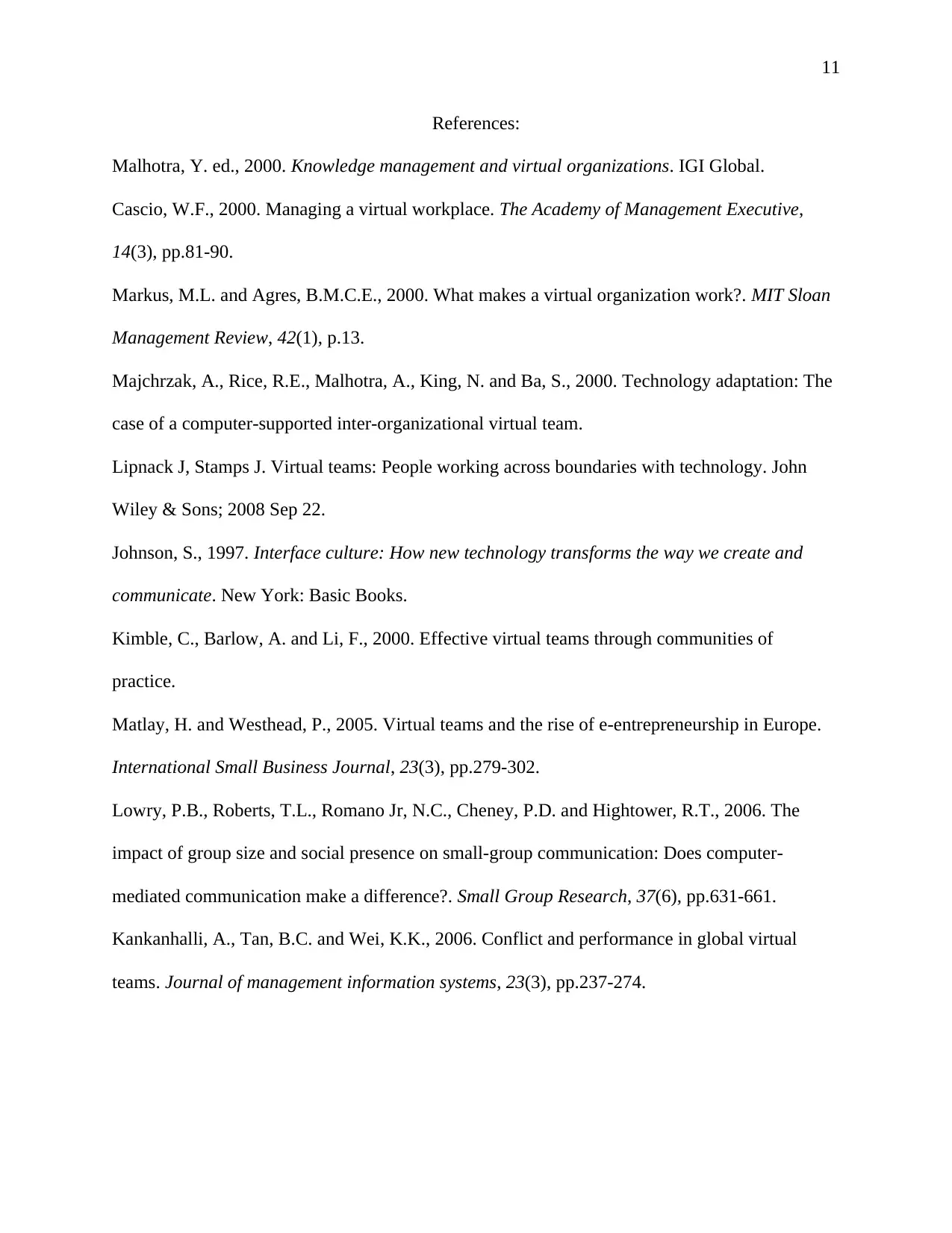
11
References:
Malhotra, Y. ed., 2000. Knowledge management and virtual organizations. IGI Global.
Cascio, W.F., 2000. Managing a virtual workplace. The Academy of Management Executive,
14(3), pp.81-90.
Markus, M.L. and Agres, B.M.C.E., 2000. What makes a virtual organization work?. MIT Sloan
Management Review, 42(1), p.13.
Majchrzak, A., Rice, R.E., Malhotra, A., King, N. and Ba, S., 2000. Technology adaptation: The
case of a computer-supported inter-organizational virtual team.
Lipnack J, Stamps J. Virtual teams: People working across boundaries with technology. John
Wiley & Sons; 2008 Sep 22.
Johnson, S., 1997. Interface culture: How new technology transforms the way we create and
communicate. New York: Basic Books.
Kimble, C., Barlow, A. and Li, F., 2000. Effective virtual teams through communities of
practice.
Matlay, H. and Westhead, P., 2005. Virtual teams and the rise of e-entrepreneurship in Europe.
International Small Business Journal, 23(3), pp.279-302.
Lowry, P.B., Roberts, T.L., Romano Jr, N.C., Cheney, P.D. and Hightower, R.T., 2006. The
impact of group size and social presence on small-group communication: Does computer-
mediated communication make a difference?. Small Group Research, 37(6), pp.631-661.
Kankanhalli, A., Tan, B.C. and Wei, K.K., 2006. Conflict and performance in global virtual
teams. Journal of management information systems, 23(3), pp.237-274.
References:
Malhotra, Y. ed., 2000. Knowledge management and virtual organizations. IGI Global.
Cascio, W.F., 2000. Managing a virtual workplace. The Academy of Management Executive,
14(3), pp.81-90.
Markus, M.L. and Agres, B.M.C.E., 2000. What makes a virtual organization work?. MIT Sloan
Management Review, 42(1), p.13.
Majchrzak, A., Rice, R.E., Malhotra, A., King, N. and Ba, S., 2000. Technology adaptation: The
case of a computer-supported inter-organizational virtual team.
Lipnack J, Stamps J. Virtual teams: People working across boundaries with technology. John
Wiley & Sons; 2008 Sep 22.
Johnson, S., 1997. Interface culture: How new technology transforms the way we create and
communicate. New York: Basic Books.
Kimble, C., Barlow, A. and Li, F., 2000. Effective virtual teams through communities of
practice.
Matlay, H. and Westhead, P., 2005. Virtual teams and the rise of e-entrepreneurship in Europe.
International Small Business Journal, 23(3), pp.279-302.
Lowry, P.B., Roberts, T.L., Romano Jr, N.C., Cheney, P.D. and Hightower, R.T., 2006. The
impact of group size and social presence on small-group communication: Does computer-
mediated communication make a difference?. Small Group Research, 37(6), pp.631-661.
Kankanhalli, A., Tan, B.C. and Wei, K.K., 2006. Conflict and performance in global virtual
teams. Journal of management information systems, 23(3), pp.237-274.
⊘ This is a preview!⊘
Do you want full access?
Subscribe today to unlock all pages.

Trusted by 1+ million students worldwide
1 out of 13
Related Documents
Your All-in-One AI-Powered Toolkit for Academic Success.
+13062052269
info@desklib.com
Available 24*7 on WhatsApp / Email
![[object Object]](/_next/static/media/star-bottom.7253800d.svg)
Unlock your academic potential
Copyright © 2020–2025 A2Z Services. All Rights Reserved. Developed and managed by ZUCOL.





